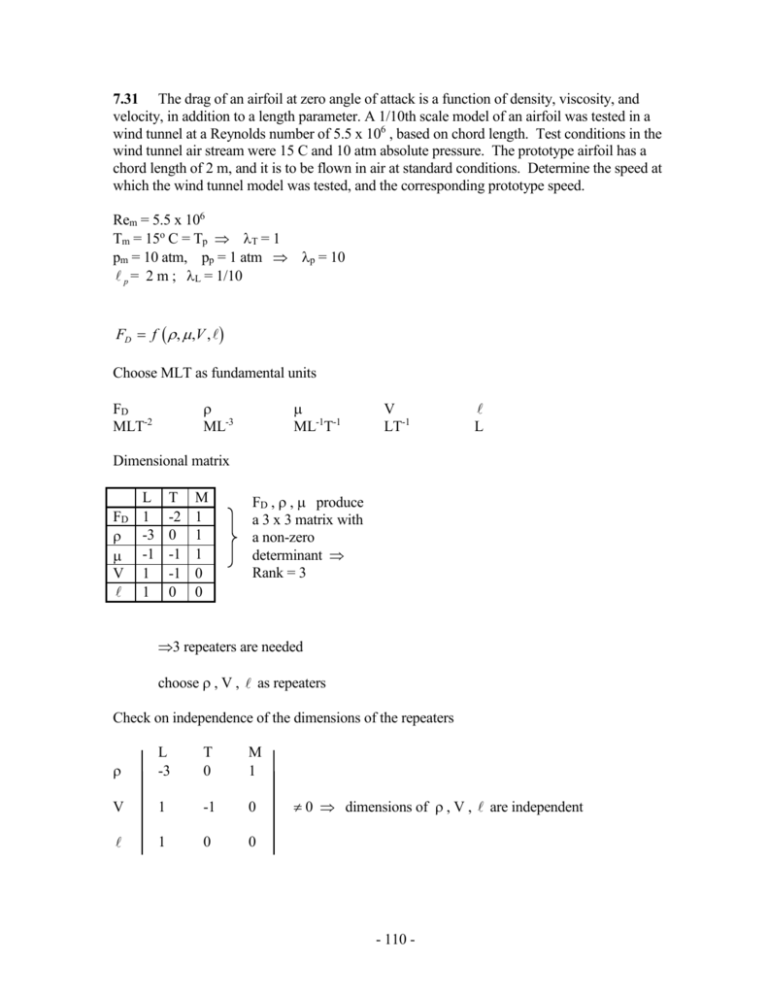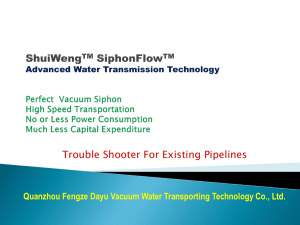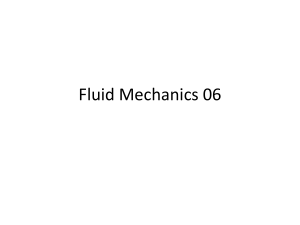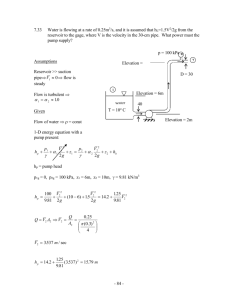Section 31
advertisement

7.31 The drag of an airfoil at zero angle of attack is a function of density, viscosity, and velocity, in addition to a length parameter. A 1/10th scale model of an airfoil was tested in a wind tunnel at a Reynolds number of 5.5 x 106 , based on chord length. Test conditions in the wind tunnel air stream were 15 C and 10 atm absolute pressure. The prototype airfoil has a chord length of 2 m, and it is to be flown in air at standard conditions. Determine the speed at which the wind tunnel model was tested, and the corresponding prototype speed. Rem = 5.5 x 106 Tm = 15o C = Tp T = 1 pm = 10 atm, pp = 1 atm p = 10 p = 2 m ; L = 1/10 FD f , ,V , Choose MLT as fundamental units ML-3 FD MLT-2 ML-1T-1 V LT-1 L Dimensional matrix FD V L 1 -3 -1 1 1 T -2 0 -1 -1 0 M 1 1 1 0 0 FD , , produce a 3 x 3 matrix with a non-zero determinant Rank = 3 3 repeaters are needed choose , V , as repeaters Check on independence of the dimensions of the repeaters L -3 T 0 M 1 V 1 -1 0 1 0 0 0 dimensions of , V , are independent - 110 - Dimensionless groups: 1 1 V 1 1 FD M 0 L0 T 0 (ML-3 )1 (LT -1 ) 1 (L) 1 MLT -2 M 0 L0T 0 M 1 1 L31 1 1 1T 1 2 1 + 1 = 0 1 = -1 ; -1 - 2 = 0 1 = -2; -3(-1) + (-2) + 1 + 1 = 0 1 = -2 1 FD V 2 2 2 2 V 2 2 M 0 L0 T 0 (ML-3 ) 2 (LT -1 ) 2 (L) 2 ML-1T -1 M 0 L0T 0 M 2 1 L3 2 2 2 1T 2 1 2 + 1 = 0 2 = -1 ; -2 - 1 = 0 2 = -1; -3(-1) + (-1) + 2 - 1 = 0 2 = -1 2 V 1 = f (2) FD f CD = f (Re) 2 2 V V For dynamic similarity, Re = 1 V 1 = 1 since Tm = Tp = 15oC and = f (T) V m 1 1 10 1 10 pp pm 1013 . 10 1013 . 12.3 kg / m 3 ; p 123 . kg / m 3 RTm 287 288 RTp 287 288 = 10 Vm V p V = 1 Re p p pp 55 . 10 6 1753 . 10 5 39.2 m / s 123 . 2 - 111 - 7.34 The fluid dynamic characteristics of a golf ball are to be tested using a model in a wind tunnel. Dependent parameters are the drag force, FD, and lift force, FL, on the ball. The independent parameters should include angular speed, , and dimple depth, d. Determine suitable dimensionless parameters and express the functional dependence among them. A golf pro can hit a ball at V = 240 ft/sec and = 9000 rpm. To model these conditions in a wind tunnel with a maximum speed of 80 ft/sec, what diameter model should be used? How fast must the model rotate? (The diameter of a U.S. golf ball is 1.68 in.) FD f , d , D, V , , Choose MLT as fundamental units FD MLT-2 T-1 d D V L L LT-1 ML-3 ML-1T-1 Dimensional matrix FD d D V L 1 0 1 1 1 -3 -1 T -2 -1 0 0 -1 0 -1 M 1 0 0 0 0 1 1 FD , , d produce a 3 x 3 matrix with a nonzero determinant Rank = 3 3 repeaters are needed choose , D , V as repeaters Check on independence of the dimensions of the repeaters L -3 T 0 M 1 D 1 0 0 V 1 -1 0 0 dimensions of , V , D are independent - 112 - Dimensionless groups: 1 1 V 1 D 1 FD M 0 L0 T 0 (ML-3 )1 (LT -1 ) 1 (L) 1 MLT -2 M 0 L0T 0 M 1 1 L31 1 1 1T 1 2 1 + 1 = 0 1 = -1 ; -1 - 2 = 0 1 = -2; -3(-1) + (-2) + 1 + 1 = 0 1 = -2 1 FD V 2 D2 2 2 V 2 D 2 M 0 L0 T 0 (ML-3 ) 2 (LT -1 ) 2 (L) 2 ML-1T -1 M 0 L0T 0 M 2 1 L3 2 2 2 1T 2 1 2 + 1 = 0 2 = -1 ; -2 - 1 = 0 2 = -1; -3(-1) + (-1) + 2 - 1 = 0 2 = -1 2 VD 3 3 V 3 D 3 d 3 = 3 = 0; 3 = -1 (by inspection) 3 d D 4 4 V 4 D 4 4 = 0, 4 = -1; 4 = 1 (by inspection) 4 1 = f (2, 3, 4) For dynamic similarity, Re = 1, St = 1 V D 1 V 80 1 240 3 Assume Tm = Tp ; pm = pp = 1 ; = 1 V D 1 V FD d D f , , CD = f (Re, St, d/D) V 2 D2 VD D V St : Strouhal number V D 1 and D 1 D 1 D 3 3 Dm = D Dp = 3(1.68”) = 5.04” - 113 - V 1 1 1 D 3 3 9 m m p 1 (9000) 1000 rpm 9 7.36 A model hydrofoil is to be tested at 1:20 scale. The test speed is chosen to duplicate the Froude number corresponding to the 60 knot prototype speed. To model cavitation correctly, the cavitation number also must be duplicated. At what ambient pressure must the test be run? Water in the model test basin can be heated to 130 F, compared to 45 F for the prototype. For dynamic similarity, Ca = 1 ( p p ) v 2 V 1 ( p p ) V2 v (see p. 295 for Cavitation Number) Model & Prototype are tested in water with = const = 1 ( p pv ) V2 Also, Fr = 1 for dynamic similarity V 1 2 1 1 2 g L 1; g 1 ( same location) V 2L ( p pv ) L p p m pvm p pv p 1 ( p pv ) 0.05 20 0.05; p p 14.7 psia , pv p pv 0.15 psia T 45 F pv m pv T 130 F p m 0.05 p p pv p pv m 0.0514.7 0.15 2.22 2.95 psia - 114 - 7.41 An automobile is to travel through standard air at 100 km/hr. To determine the pressure distribution, a 1/5-scale model is to be tested in water. What factors must be considered to ensure kinematic similarity in the tests? Determine the water speed that should be used. What is the corresponding ratio of drag force between prototype and model flows? The lowers pressure coefficient is Cp = -1.4 at the location of the minumum static pressure on the surface. Estimate the minimum tunnel pressure required to avoid cavitation, if the onset of cavitation occurs at a cavitation number of 0.5. Factors necessary to ensure kinematic similarity: -model and prototype must be geometrically similar -model must be completely submerged to avoid surface effects -cavitation effects must be absent in model testing For dynamic similarity, Re 1 1 5 D ; DV 1 D V 1 v vm v water / T 20C ( assumed ) 1 106 m2 / s v 0.069 v p vair / T 15C 145 . 10 5 m2 s v 0.069 0.345 1 D V 5 Vm V V p 0.345 100 9.58m / s 3.6 Also for dynamic similarity, CD FD 1 V 2 D 2 2 F D V2 2D p 1 FD 2 9.58 1 2 2 3 V D 4.758 10 100 5 3.6 101.3 10 3 kg 1.23 3 ; 287 288 m m 1000kg / m 3 F 4.758 10 3 0.813 103 3.87 D - 115 - 1000 0.813 10 3 1.23 Head loss and friction factor 1-D energy equation: p1 1 2 2 p V1 V z1 2 2 2 z 2 hlT 2g 2g T means ‘total’ For fully-developed flow through a constant-diameter pipe, V1 V2 p1 p2 z2 z1 hl major and if the pipe is horizontal, z1 z 2 p1 p2 p hl major (i) Consider flow in a straight pipe: Free-body diagram of fluid Ff mg r p1 d x Momentum equation in the x-direction: V2 V1 p1 A p2 A Ff m p1 p2 Ff V2 V1 x A (ii) wall shearing stress dynamic heat [ f’ = Fanning Friction Factor] Drag coefficient: f ' - 116 - Ff p2 f ' w 2 V 2 (iii) Hydraulic diameter: Dh Adx 4A (iv) 4 dAw dAw dx w means wetted dAw P (wetted perimeter) dx For a circular duct of diameter D, and length L, 4 D 2 4A 4 Dh D DL P L For a rectangular duct of cross-section as shown: h 4bh 2h 2h Dh 2b h 1 h 1 AR b where AR (Aspect Ratio) = b h b V 2 Adx Ff w dAw f ' 4 2 Dh V 2 dx Ff 4 f ' A 2 Dh Darcy Friction Factor f 4 f ' 2 dx 1 with (ii) p1 p2 4 f ' V 2 A Dh A p1 p2 f f V 2 dx 2 Dh p1 p2 V 2 dx 2 Dh hl major V 2 dx 2 Dh ghl major V 2 dx 2 Dh ghl major V 2 dx 2 Dh - 117 - For a pipe of length L and diameter D ghl major f 2 V L 2 D hl major V2 L 2g D (Darcy-Weisbach Equation) hl major hQ, , D, L, v h Re, D V L 2g D hl major 2 LAMINAR FLOW THROUGH PIPES z 2 s F2 Fs 1 F1 Fs ds ds r R dz dW F1 p dA; p F2 p ds dA; s Fs 2r ds dW r 2 ds If flow is steady and uniform at (1) & (2) then the momentum equation in the s-direction gives: F s V2 V1 F1 F2 Fs dW cos 0 m - 118 - p pdA p ds dA 2r ds r 2 ds cos 0 s p dA dsdA 2 ds dAds cos 0 r s dA r 2 r dA r p dz 2 0 s r ds r p dz r d p z since p varies only in the s-direction 2 s ds 2 ds Newton’s law of fluid viscosity: 0 dU r d p z dr 2 ds dU U max 1 2 0 1 2 0 U max U max max R d ds p z rdr R 2 d r p z 2 0 ds d ds p z R2 4 dU max Rd p z dR 2 ds More generally, 0 U dU 1 2 1 0 U 2 R r d ds p z rdr R 2 d r p z 2 r ds - 119 - dU dr U 1 4 d 2 2 ds p z R r Volumetric flow rate: Q U dA U 2r dr R A Q R 0 R 0 Q 2 4 2 Q 4 Q r2 d p z 2r dr 4 ds 2 d R 2 2 p z 0 R r r dr ds R 2 r4 d 2 r p z R 2 4 0 ds 4 2 d R4 R p z 4 ds 4 2 R 4 d Q p z V A 8 ds V R 4 8 d p z 2 ds R d p z 2 8 ds R For a horizontal pipe, dz 0 z const R 4 dp and for a length, L, of the pipe, Q 8 ds Q R 4 p D 4 p (Hagen-Poiseuille equation) 8 L 128 L p 128 L 128 L D 2 Q V D 4 D 4 4 - 120 - p 32 LV L V 32 2 D D D L L 2 1 p 32 V 2 32 V D D VD Re D 2 L V but p ghl major gf D 2 g [ hl major 2 L V Darcy-Weisbach Equation] f D 2 g 2 1 L V L gf 32 V 2 D 2 g D Re D f f 64 Re D Example Re Water flows in a pipe 2 cm in diameter and 30 m long; the pipe is running full. Find the head loss when the temperature is 5C and the velocity is 10 cm/s. v 151 . 10 6 m2 / s (see Fig. A.3, p. 764, Text) Re VD 0.1 0.02 1324.5 Re 2000 flow is laminar v 1.51 10 6 f 64 64 0.0483 Re 1324.5 2 . L V 30 01 f 0.0483 3.7 10 2 m of water D 2 g 0.02 2 9.81 2 head loss: hl major hl major 3.7cm of water - 121 - Oil at 60F has a specific gravity of 0.92 and kinematic viscosity of 0.0205 ft2/s. Find the horsepower required to pump 50 tons of oil per hour along a pipeline 9 in diameter and one mile long. S .G.oil 0.92 oil 0.92 62.4 57.4lbf / ft 3 v 0.0205 ft 2 / s Volumetric flow rate: Q m g W 50 tons / hr 50 2000 lbf / hr g 57.4 lbf / ft 3 57.4 lbf / ft 3 1742.16 ft 3 Q 1742.16 ft / hr 0.484 ft 3 / s 3600 s 3 2 9 2 D Q 0.484 12 A 0.4418 ft 2 ; V 1.096 ft / s 4 4 A 0.4418 9 1.096 VD 12 40.1 2000 Re flow is laminar v 0.0205 f 64 64 1596 . Re 401 . 2 . 5280 1096 L V 1596 . 209.6 ft of oil f 9 D 2 g 2 32.2 12 2 head loss: hl major Horsepower Q hl major 550 57.4 0.484 209.6 10.6 h. p. 550 Note: 1 h. p. 550 ft lbf / s Example Velocity measurements are made in a 30-cm pipe. The velocity at the centre is found to be 1.5m/s, and the velocity distribution is observed to be parabolic. If the pressure drop is found to be 1.9 kPa per 100m of pipe, what is the kinematic viscosity of the fluid? Assume that the fluid’s specific gravity is 0.90. - 122 - Velocity distribution is parabolic flow is fully developed and laminar V Vmax 0.75 m / s 2 VCL = Vmax = 1.5 m/s 2 p p D 2g L V f hl major f D 2 g L V 2 19 . 103 0.3 2 9.81 f 0.0225 0.90 103 9.81 100 0.75 2 f 64 DV 64 since flow is laminar Re Re v f 2 DVf 0.3 0.75 0.0225 5 m v 7.91 10 64 64 s TURBULENT FLOW IN PIPES 2 L V The Darcy-Weisbach equation: hl major f can still be used to determine the head loss D 2 g due to friction but f now depends upon the Reynolds number (Re) and the relative roughness e (e/D); f F Re, see the MOODY DIAGRAM D Example Determine the head loss due to flow of 100 litres/s of glycerine at 20C through a 100m length of 20cm diameter pipe made of cast iron. Rework the problem for the case when the working fluid is water. S. G.Glycerin 126 . (see Table A2, p.759, Text) - 123 - Glycerin / T 20C 15 . H O / T 20C 998 2 Ns (see Fig. A.2, p.763, Text) m2 kg (see Handout) Glycerin/ T 20C 126 . 998 12575. kg / m3 3 m 3 litres m3 3 m Q 100 100 10 01 . s s s A V 0.22 4 Q 0.1 3.185 m / s A 0.0314 Re D f 0.0314 m 2 V D 1257.5 3.185 0.2 534 2000 Flow is laminar 1.5 64 64 012 . Re 534 2 100 3.185 L V 0.12 31.0 m of Glycerin hl major f D 2 g 0.2 2 9.81 2 If water is the working fluid, then Ns H 2O / T 20C 1 10 3 2 (see Fig. A.2, p.763, Text) m Re D V D 998 3.185 0.2 635726 2000 flow is turbulent 1 10 3 D 20cm 7.874" e 0.0013 (see Fig. 8.15 for Cast Iron, p.351) D e f F Re, F 6.36 105 , 0.0013 f 0.021 (see Moody diagram) D . LV2 100 3185 f 0.021 5.43m of water 0.2 2 9.81 D 2g 2 hl major - 124 - Determine the discharge of water at 20C through a pipe, made of cast iron, with a diameter of 20cm if the head loss in 100m length of pipe is equal to 5.43m. Re, V and f are unknown hl major f LV2 D 2g V 2 gDhl major L where c1 2 gDhl major Re V D Re c 2V where c2 f 1 2 c1 f L v D v Solution Procedure: (i) Determine e D (ii) Assume a value for f using the Moody diagram. (Locate e D and move horizontally across the diagram to the f axis) (iii) Using f calculate V from V c1 f (iv) Use V to determine Re from Re c2V (v) Using e D and Re, determine f (vi) Compare f obtained in (v) with f assumed in (ii). If they are the same, STOP. If not, repeat steps (iii) through (vi) until convergence is attained D 2 (vii) After convergence calculate the discharge using Q V 4 6 2 v 1 10 m / s (see Fig. A.3, p.764, Text) e 0.0013 for Cast Iron with D 20cm 7.874" (see Fig. 8.15, p.351, Text) D L = 100 m, D = 20 cm = 0.2m, hlmajor = 5.43m hl major f LV2 VD , Re D 2g v - 125 - [2 equations with 3 unknowns (Re, V , f ) iteration is needed] V c1 f , Re c2V 2 gDhl major c1 L V 0.462 c2 2 9.81 0.2 5.43 0.462m / s 100 f D 0.2 s 2 105 6 v 1 10 m Re 2 105V From the Moody diagram, with V e 0.0013 f 0.021 D 0.462 319 . m/ s 0.021 Re 2 105 319 . 6.38 105 f F 0.0013, 6.38 105 0.021 f assumed convergence is attained Q AV 0.22 4 3.19 0.1 m 3 s Re, V , f and D are the unknowns hl major LV2 Q 4Q f , V D 2g A D 2 hl major L 4Q 1 f 2 D D 2 g 8LQ 2 f c3 f D hl major g 2 5 c3 c3 is known - 126 - Re 4Q V D 4Q D 4Q 1 c4 where c 4 2 2 v v D v D D D c4 is known Solution Procedure: (i) Assume a value for f (ii) Calculate D from D 5 c3 f (iii) Calculate e D (iv) Calculate Re from Re c4 D (v) Using e D and Re, determine f (vi) Compare f obtained in (v) with f assumed in (i). If the two values are approximately the same, STOP. If not, repeat steps (ii) through (v) until convergence is attained Example Determine the size of a cast iron pipe required to convey 100 litres/s of water at 20C with a head loss of 5.43m in a 100m length of pipe. Q 100 litres / s 0.1 m 3 / s hl major 5.43 m ; v 10 . 10 6 m2 / s L 100m ; 8LQ 2 8 100 0.1 0.01522 2 hl major g 5.43 9.81 2 2 c3 D5 c3 f 0.01522 f c4 4Q 4 0.1 1.27 10 5 6 v 1 10 Re c4 127 . 105 D D - 127 - Iteration #1 Assume f = 0.01 D 0.015220.01 1 5 0172 . m 6.772" e 127 . 105 1453 . 10 3 ; Re 7.38 105 D 0172 . e f F , Re F 1453 . 10 3 , 7.38 105 f 0.022 D Iteration #2 Assume f = 0.021 D 0.015220.021 Re 1 5 0.2m 7.874" 127 . 105 6.35 105 ; 0.2 e 0.0013 D e f F , Re F 0.0013, 6.35 105 0.021 f assumed D Convergence is attained D = 0.2m - 128 -







